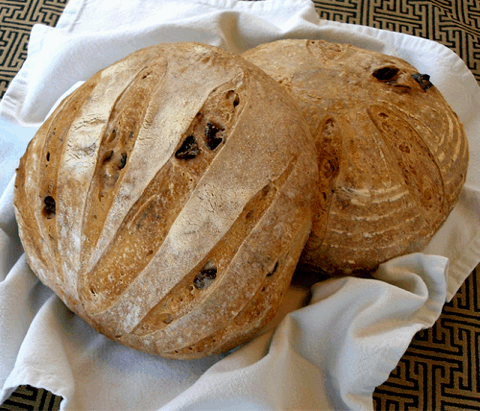
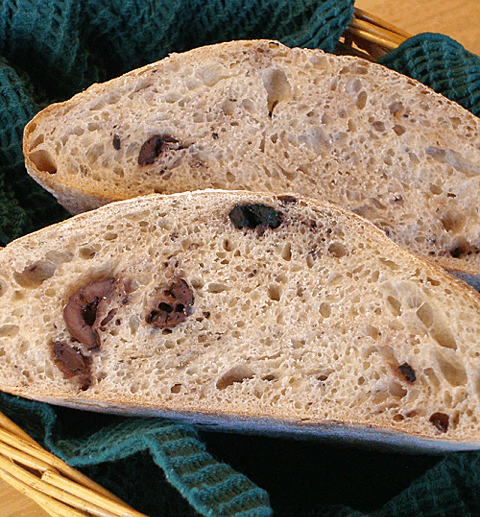
The loaves should have a golden, very crispy, blistered, crust and a chewy texture with a nice sourdough tang, which is just the way we like them. We use our Wild Yeast Sourdough Starter that we have put together in an easy-to-follow recipe tutorial for you.
BREAD RECIPE HELP
INGREDIENTS
3 3/4 to 4 cups unbleached all purpose of bread flour; spoon into measuring cup and level to rim
1/2 cup white whole wheat flour
1 1/2 cups water, at warm room temperature
1 cup ripe wild yeast sourdough starter
2 teaspoons salt
1 teaspoon sugar(optional)
1 cup kalamata olives, pitted, halved and dried on paper towels
1 teaspoon fresh rosemary, finely chopped
OPTIONAL EQUIPMENT:
To keep the dough nice and round while it is rising, you need to use a proofing basket or a round bowl lined with a floured kitchen towel.
You can find the proofing baskets online. The baskets are also called “brotforms”, but some of them are wildly expensive.
Here are some options:
http://www.breadtopia.com/store/bread-baking-supplies.html
If you want to order several sizes and shapes you can put together a wholesale order here. The minimum order is $50.:
http://www.luckyclovertrading.com/rattan-coil-proofing-basket-p-1168.html
The advantage of using a brotform is that the floured coils make a nice decorative pattern on the finished loaves.
If this is not important to you, using a towel-lined bowl works great too.
We show you both options with the recipe.
INSTRUCTIONS
STEP I: MAKE THE DOUGH
1. In the bowl of a stand mixer fitted with a dough hook attachment, add 3 3/4 cups flour, white whole wheat flour, water, and starter.
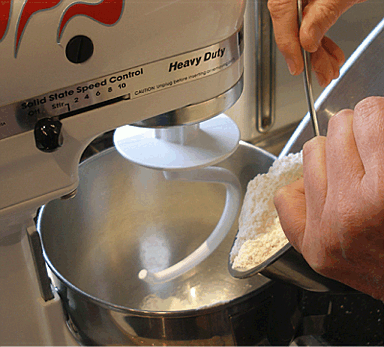
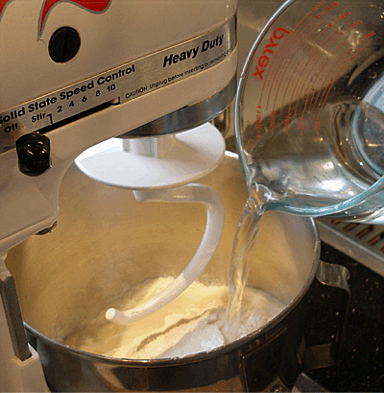
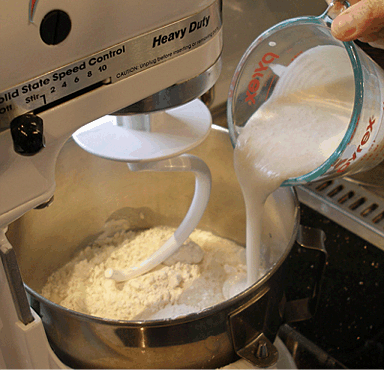
2. Mix at low speed until combined.
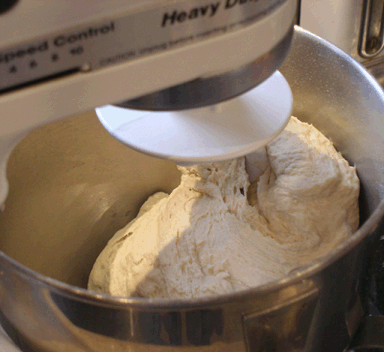
3. Cover the bowl with a clean kitchen towel and let the dough rest for 30 minutes. This will allow the flour to absorb the liquid, a process called autolysis.
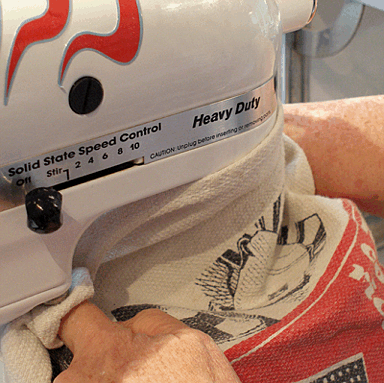
4. After the 30 minute rest, add the salt and optional sugar to the bowl.
Knead the dough for about 4-5 minutes by turning on the mixer to medium speed.
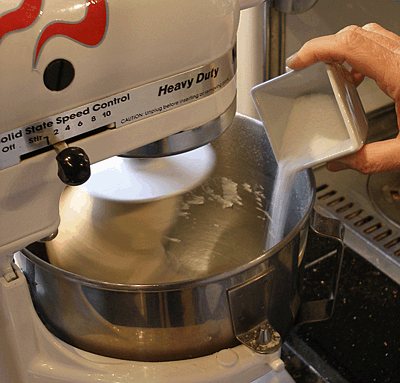
5. Stop the mixer and check the dough. It should be slightly sticky, and start releasing from the sides of the bowl and start wrapping itself around the dough hook during kneading.
If your dough is too sticky, you may add the remaining flour, 1 tablespoon at a time, with the mixer on low, until it resembles the dough in the photo below.
Do not add too much flour. The dough is not supposed to be stiff.
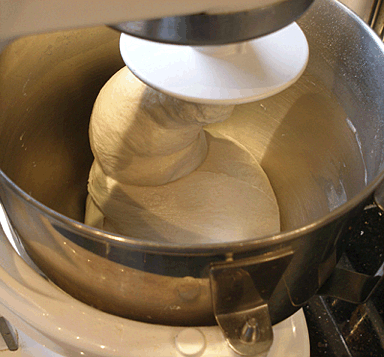
5. Add the chopped rosemary and mix on medium until it is evenly incorporated.
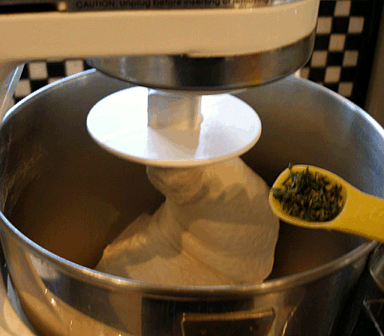
6. Scrape the dough out onto a floured work surface. Spread it gently into a rough square. Sprinkle the olives over the bread.
Knead the olives into the dough until they are well incorporated.
NOTE: It is best to do this step by hand so you don't tear up the olives. Kneading the olives into the dough in the mixer can leave you with a strangely purple-ish dough.
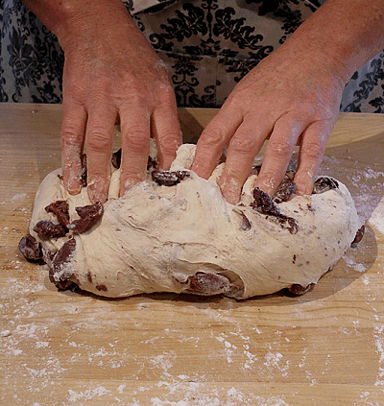
STEP II: THE FIRST RISE AND SHAPE THE BOULE
The first rise:
1. After kneading in the olives, scrape the dough into a greased bowl, turning the dough over so the top of the dough is oiled.
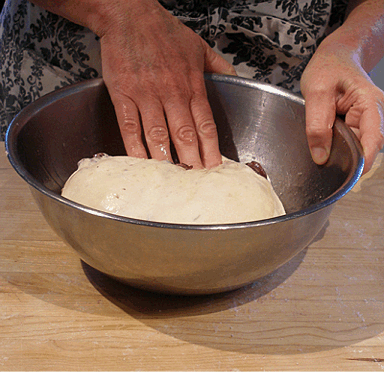
2. Place plastic wrap on the bowl and set it aside, in a warm place, for 3 1/2 to 4 hours, or until doubled.
NOTE: Sarah's Microwave Bread Proofer is PERFECT for this step and will shorten the rising time.
Form the loaves:
1. After the first rise, tip the bowl and let the dough fall onto on a floured surface.
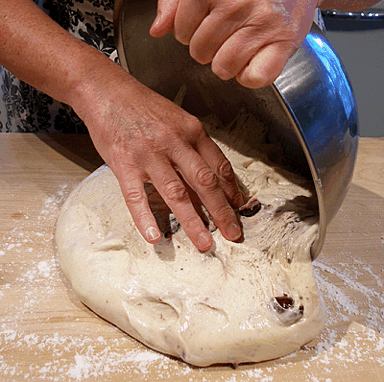
2. Cut the dough in half with a bench scraper.
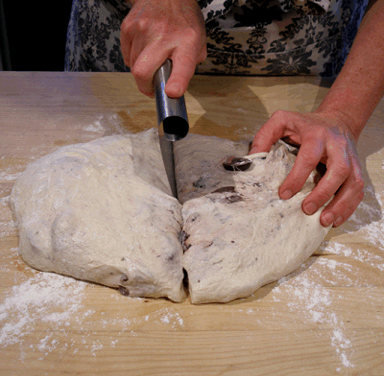
Loosely cover one 1/2 of the dough with greased side-down plastic wrap while you shape the other half.
3. Gently stretch and flatten the dough into a roundish shape.
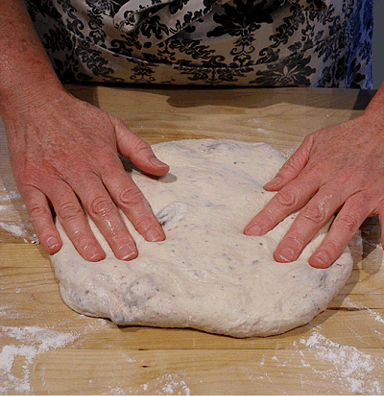
4. To form the boule:
a. Go around the outside of the circle and fold the outer edges toward the center, pressing each fold in at the center of the circle.
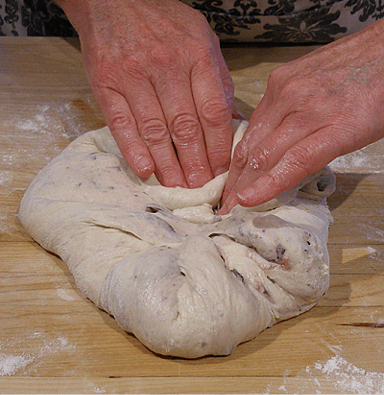
b. When you have folded in all the edges, you should have a nice round shape.
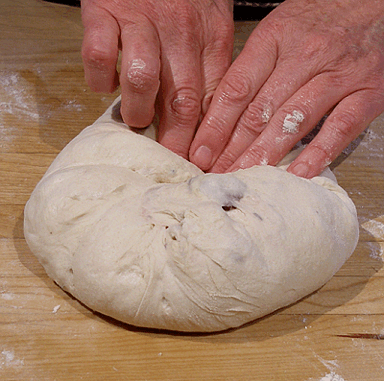
c. Flip the round over, and cup the dough in your hands, then turn the dough on the work surface. It is best to do this on a part of the work surface that does not have a lot of flour on it, so the bottom of the dough can grip the table a little as you turn the dough.
Repeat this movement several times until the skin of the dough at the top is nice and tight, and the dough is beautifully rounded.
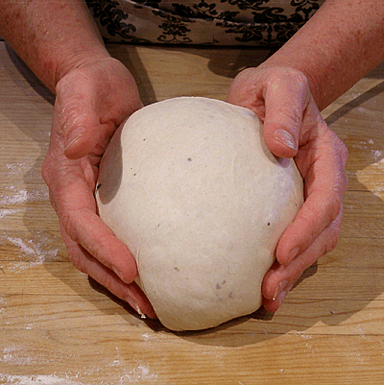
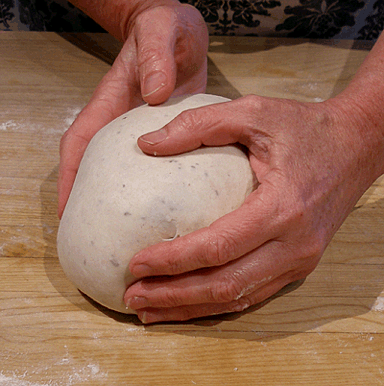
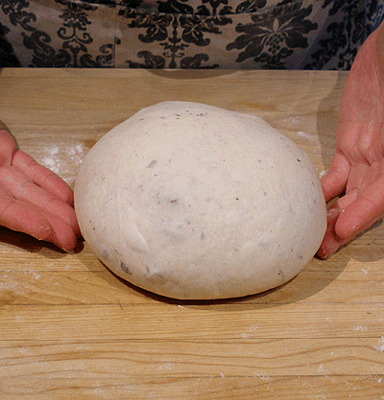
5. To keep the dough nice and round while it is rising, you need to use a proofing basket or a round bowl lined with a floured kitchen towel.
The baskets are also called “brotforms”, but some of them are wildly expensive.
The advantage of using a brotform is that the floured coils make a nice decorative pattern on the finished loaves.
If this is not important to you, using a towel-lined bowl works great too.
We show you how to use both options.
a. If you have a proofing basket, flour it well and place the formed boule in it, TOP SIDE DOWN.
Cover it with plastic wrap, or a kitchen towel, while you form the second loaf.
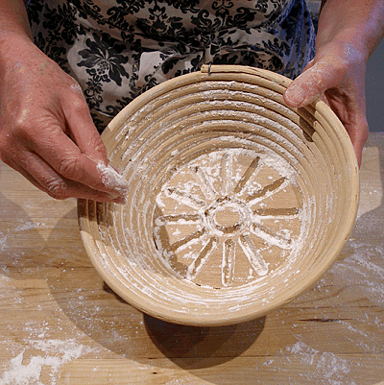
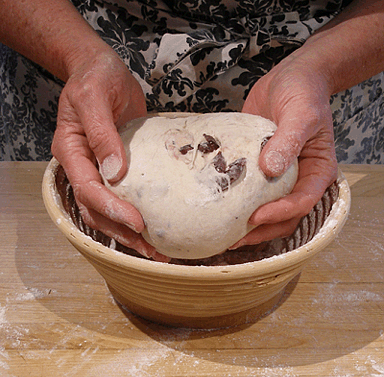
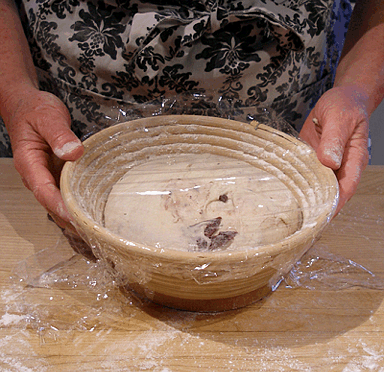
NOTE: If you do not have a brotform, or you only have one, like I do , choose a medium sized round bowl as a stand-in.
1. Generously flour a SMOOTH kitchen towel with flour. You cannot use terry cloth or textured towels for this purpose!
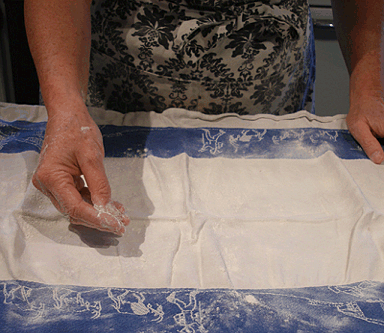
2. Push the floured towel into the bowl, leaving as few folds as possible.
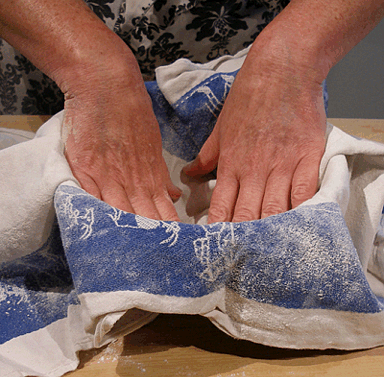
3. Place the formed boule into the lined bowl, TOP SIDE DOWN.
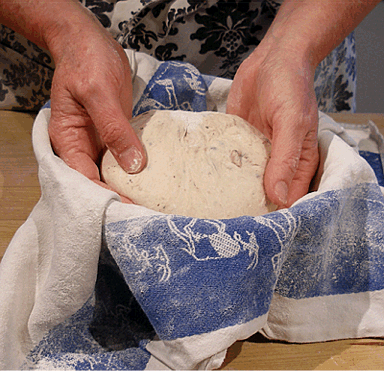
STEP III: THE SECOND RISE AND BAKE THE LOAVES
The second rise:
1. After you have shaped both loaves, place the bowls on a baking sheet, and cover them with a clean kitchen towel and set aside for 1 hour to proof or rise.
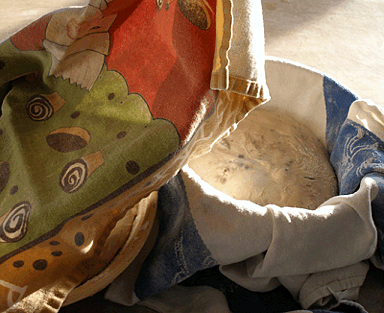
2. After the loaves have risen, place the baking sheet in a large plastic bag and set it in the refrigerator overnight.
This process, called retarding, slows down the fermentation of the dough and greatly improves the taste and texture of the bread.
Bake the bread loaves:
1. The next morning, remove the bread from the refrigerator and take it out of the plastic bag. Cover the loaves with a clean kitchen towel and let them rise, at warm room temperature, for about three hours, or until doubled in size(double the original size, before the overnight stay in the fridge).
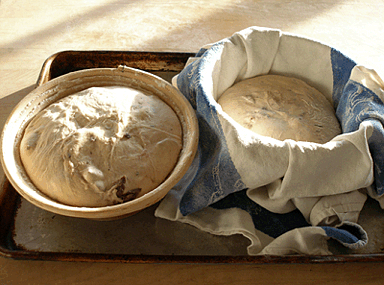
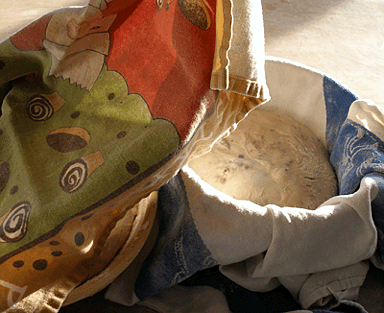
2. After the dough has been rising for two hours, place the oven shelf to the lowest rung. Place two pizza stones in the oven shelf.
Preheat the oven to 450 degrees F.
NOTE: If you have an electric oven, place the oven shelf on the lowest rung, and then one right above.
3. When the loaves are ready to bake, place about 18 ice cubes on an old baking sheet and place it on the floor of your oven. As the ice melts, it will form steam in the oven, which will give your loaves a nice crispy crust.
NOTE: If you have an electric oven, place the pan with ice on the lowest rack, and place the pan of ice on that.
Do not use a nice baking sheet for this job, because it will, most likely end up warping. I keep one ugly baking sheet ion my cupboard just for this use.
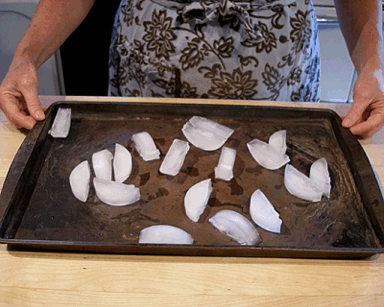
4. Generously flour a baking peel or an upside down baking sheet and unmold one of the boule on it.
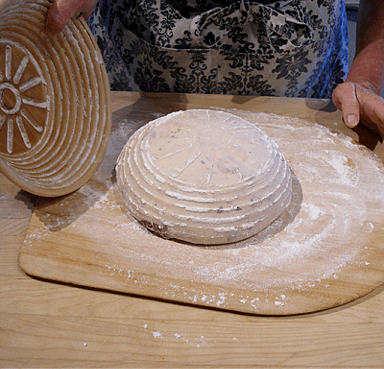
5. Using a baker's lame, or a single edged razor blade, cut several slashes in top of the loaf.
The slashes allow the bread to expand, without tearing, while it bakes.
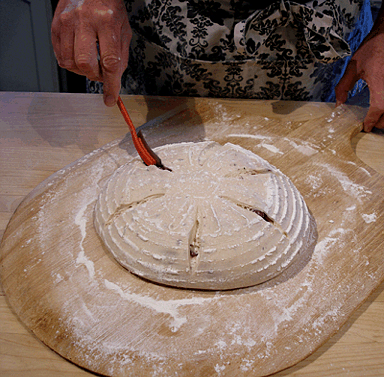
Repeat Steps 4 and 5 with the second loaf.
NOTE: If you are using a cloth-lined bowl, sprinkle flour on top of the loaf before slashing.
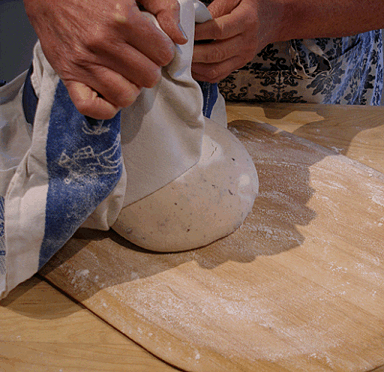
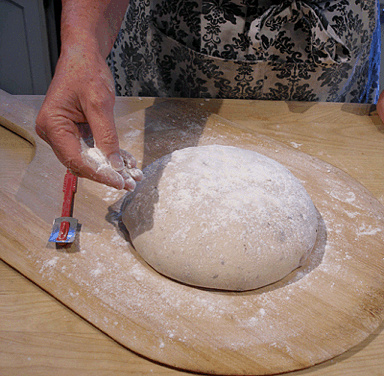
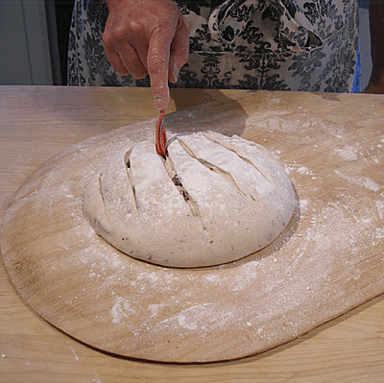
5. Slide loaf onto the preheated pizza stone and quickly close the door.
Repeat the process with the other loaf.
6. Bake the loaves for 12 minutes, then remove the baking sheet with ice(there may not be any ice left at this point).
7. Lower the oven temperature to 425 degrees F and continue to bake for 12- 16 minutes, or until the loaves are nicely browned and sound hollow when you tap them on the bottom.
The loaves should have a golden, very crispy, blistered, crust and a chewy texture with a nice sourdough tang.

As tempting as it may be, you MUST allow the bread to fully cool before you dive in and eat it.
Oh man, It's SO GOOD!

STORAGE
Store the loaves in paper bags and not in plastic wrap, but are best eaten the day they are baked because they stale quickly. For longer storage, wrap the bread in plastic wrap, place in a resealable plastic bag and freeze or store in a cool, dark place, but their crusts must be recrisped.


